This is the first in a series of posts on accessible KAIS Tools available as “apps,” software, or URLs on the Internet. All of such posts are brief overviews, not exhaustive reviews. The goal here is to introduce the distinctive value of each example tool and an example usage, in accordance with the overall goal of this website–Koine Accessible Insights. All apps and software cited here are from within the Macintosh OS, iOS “ecosystem.”
Scripture Direct (SD)
Scripture Direct is a free, iPhone and iPad downloadable app. It is also available for the Mac OD by submitting one’s EM and activating Scripture Direct’s “license key” and downloading the software. However, by default on the Mac it cannot be installed because the software is from an “unidentified developer,” and presumably not assured to be safe.
Architecture of Scripture Direct (SD)
Scripture Direct (hereafter SD) is a phrase by phrase interlinear of the Koine in Koine (Greek) script in the Koine mss word order, with an English translation directly below. It is believed that the Koine is NA27. The English translation is one done by SD, so it is not one of the ‘standard’ English translations.
The architecture is particularly helpful because it presents an overview of all the sections (pericopes) of the respective Bible book, which is of course an interpretation, and within each section the phrasing, again another interpretation. And the headings of the sections are likewise SD’s own interpretative summary. All of this seems well-done, but as discussed elsewhere all divisions, including verses and chapters, and section headings (pericope titles) are always an interpretation as none such are part of the mss.
Shown below is how SD presents Ephesians (as far as the screen grab pictures it):
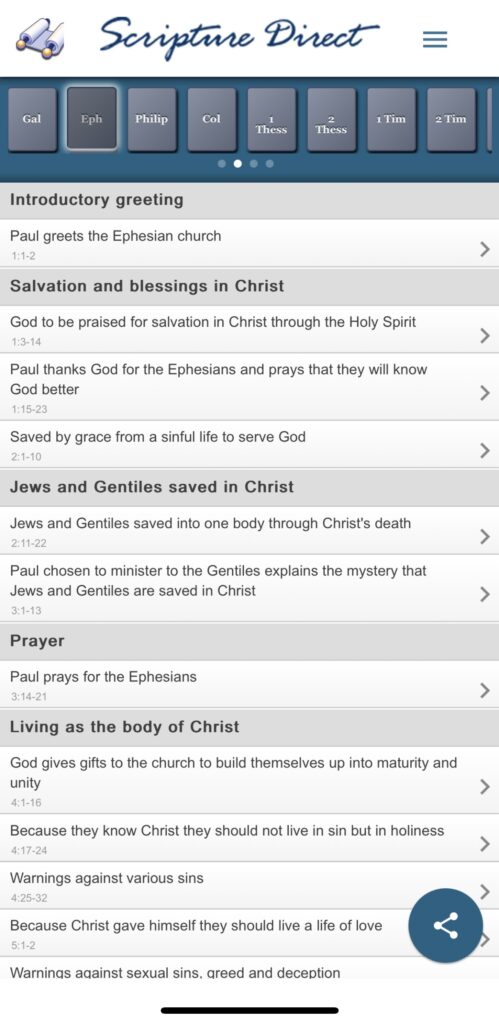
SD Ephesians 5:1-2
Drilling down on two particular verses, Eph 5:1-2, SD provides the below:
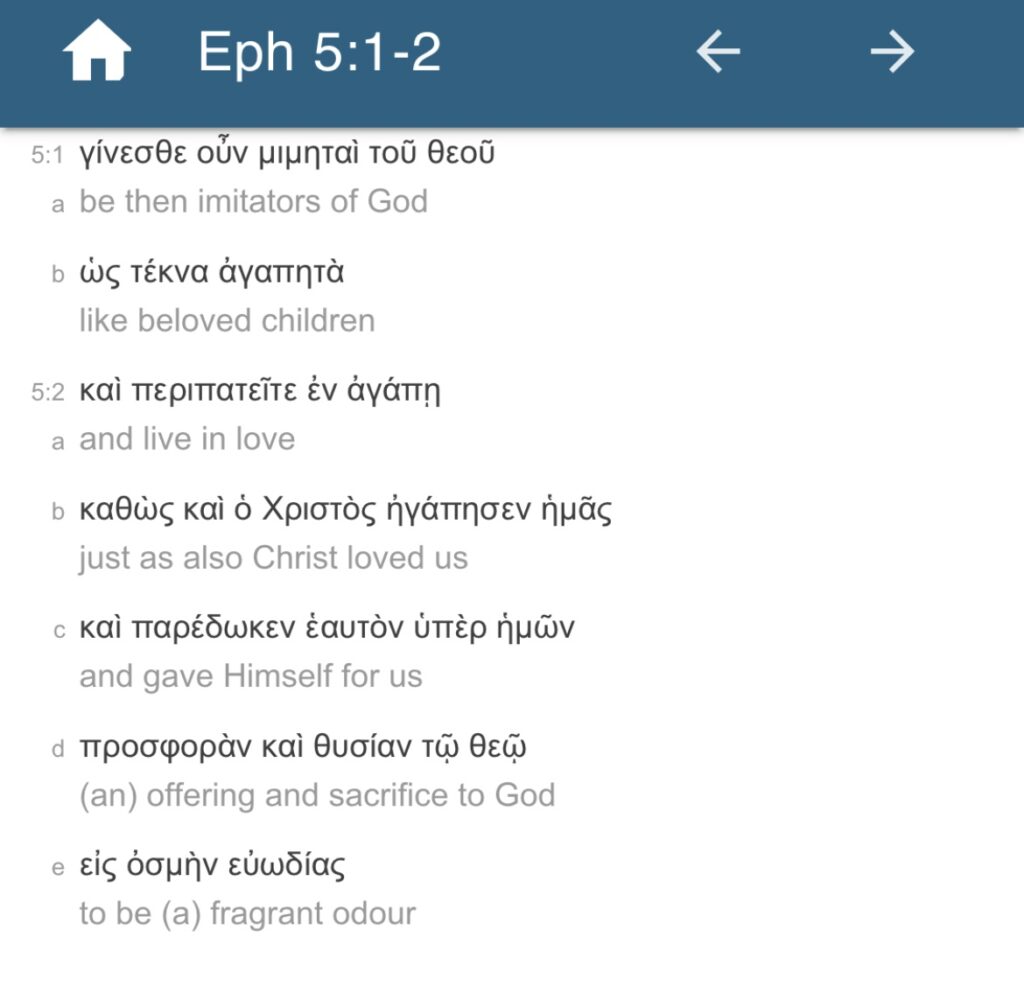
As shown above, SD presents the Koine mss in a series of phrases with each phrase given an English word translation directly below. Such phrasing is not “versified” but the respective verse from which the phrases are segmented is always shown. This is an extremely useful feature as it enables grasping the Koine in accessible units (phrases).
It is extremely helpful to know the Koine Greek alphabet and be able to pronounce the mss words even if one does not know the meaning of any particular word, or any word at all. However it is in not essential to have such knowledge as shown below.
SD Ephesians 5:1 Drill Down to Koine Word Form and Translation of “Imitators”
By single clicking on a Koine word, SD underlines such word and the English word translated from it. By double-clicking SD also opens a screen of expanded information showing (1) the word “morphology” and (2) a lexicon definition. Shown below is the result of double-clicking on the important word “imitators” in Eph 5:1.

The highlighted Koine word is shown to be translated by “imitators” and upon the second click SD gives the word form in the mss–namely that the word is a noun, in the nominative case, in the plural masculine form. The Koine in Greek alphabet, is shown within the dark blue banner above with the root word of “imitators” with its genitive case ending (transliterating it here “ou”) and “m” for masculine; such word summary is a standard lexical entry.
Shown in the light blue banner is the category, “imitator,” to which this word belongs (obvious in this example) according to the particular lexicon used by SD, namely “Louw Nida” (LN). The LN lexicon as discussed elsewhere has a very particular, and very useful, form known as “semantic domains.” So, here, SD gives the “LN Number,” namely 41.45. LN and semantic domains is discussed elsewhere on this site.
Clicking yet a third time, this on “imitator” in the light blue banner does to the LN lexicon as shown below:
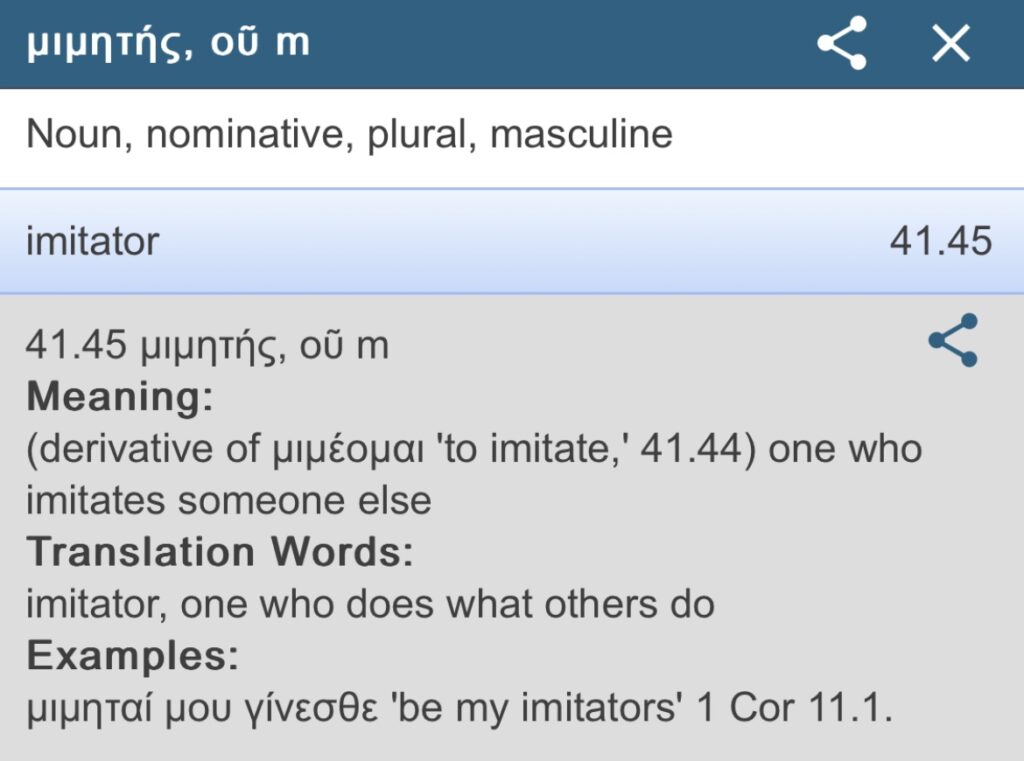
As above, LN provides an English translation (“meaning), and brief explanation, and other Bible Koine examples. This particular example is very simple because the word it simple to translated, but the understanding and living out is a epically deep idea.
Although not specific to SD, it is worth observing the following. One can think of two categories of Koine word complexity: complex and simple. And one can think of two categories of putting Scripture into life-practice / meaning, again complex and simple. This gives us four combinations.
| Simple Koine | Complex Koine | |
| Simple Significance | SK:SS | CK:SS |
| Complex Significance | SK:CS | CK:CS |
Our example here with the word “imitator” is SK:CS, meaning the Koine word itself is simple to grasp: we all known what it means to be an “imitator.” But the significance (S) of application is complex, “CS.” What does it really mean, to be an “imitator of God” in one’s Christian life? Eph 5:1-2 helpfully expands on this issue, as discussed in detail in another post, and in a real sense the entire ‘practical’ chapters of Ephesians, namely Ch 4-6, does even further, and the entirety of the Ephesian Epistle still further, and the NT yet further beyond that. The Bible is an endless web of dimensionally connectedness and illumination.
SD Drill Down Eph 5:1 on a Complex Word: “Be”
The below SD screen shot gives the drill down for the verb in Eph 5:1, “be:”
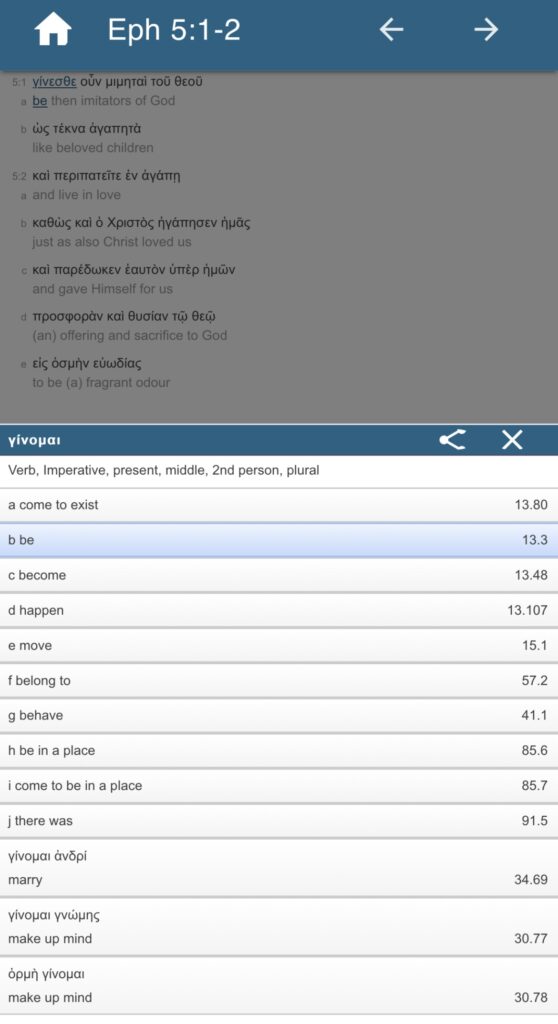
Double clicking on the first Koine word in Eph 5:1, shows it to be translated by the word “be.” Clicking again then gives the LN lexicon semantic categories to which such word could fit. The multiplicity of such categories contrasts with the above drill down on “imitators” showing that “be” though just a small two-letter word is one of potential great complexity.
Shown directly below the dark blue banner is the word morphology: it is a verb, in the imperative “mood” (command form), in the present “tense” (or “aspect”), 2nd person plural (meaning ‘you-all’) and the middle voice (discussed elsewhere, basically meaning active voice reflexing back onto oneself). As discussed elsewhere, Koine verbs have a much richer morphology than nouns as they disclose many different dimensions of actions or being.
Shown below the morphology line are all the LN categories into which “be” could ‘fit’ depending upon the context (all in the judgment of Dr.s Louw and Nida, creator of this semantic domain lexicon). Highlight in the light blue banner is LN 13.3 which is the believed appropriate category.
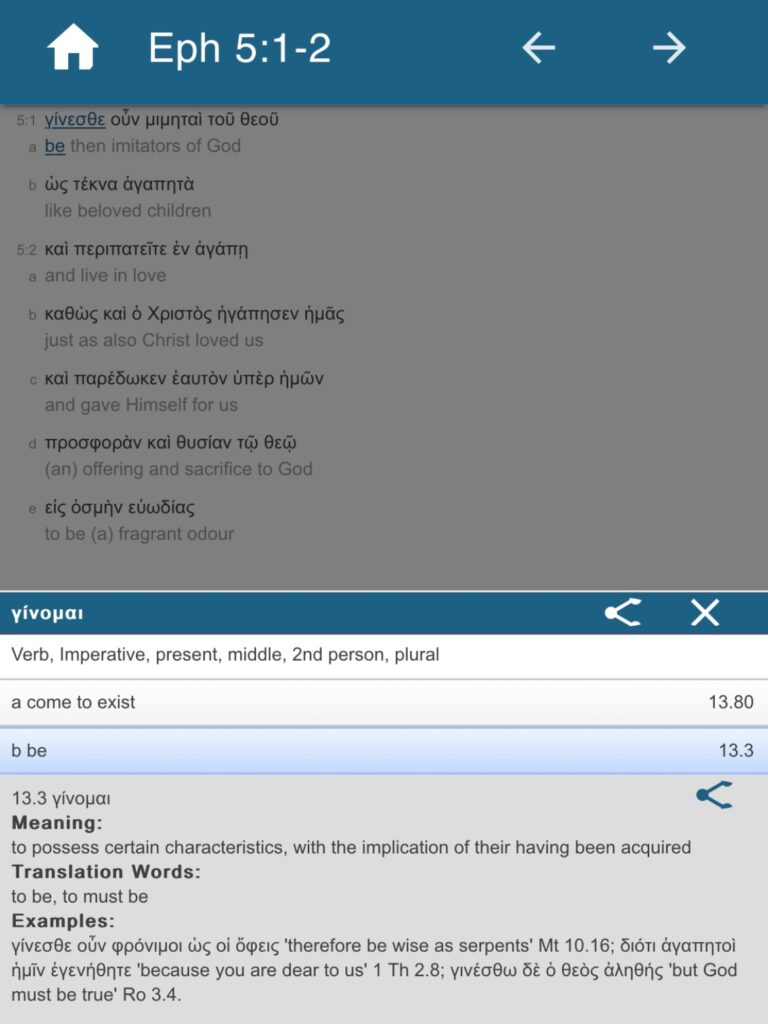
And by clicking on the recommended LN category, the lexicon gives the meaning, translation, and examples shown above.
Verbs of being, such as “be,” are very common in Koine and English, intuitively understood, but complex is range of meaning as well as application significance.
SD and Identifying “kai” in Contexts
As discussed elsewhere, the extremely common, and well-worth knowing, Koine word “kai” is obscured in English translations. For this KAIS website, we assume that the reader is not a fluent Koine reader or scholar. So one challenge then is identifying where “kai” occurs and then considering how the various English translations handle (or ignore) such key word, and what deeper insight might be appropriate for its use regardless of the word used to translate it.
SD can be very helpful in such task of finding “kai” wherever it occurs. The below is again from SD for Eph 5:1-2 as it is phrased in SD:
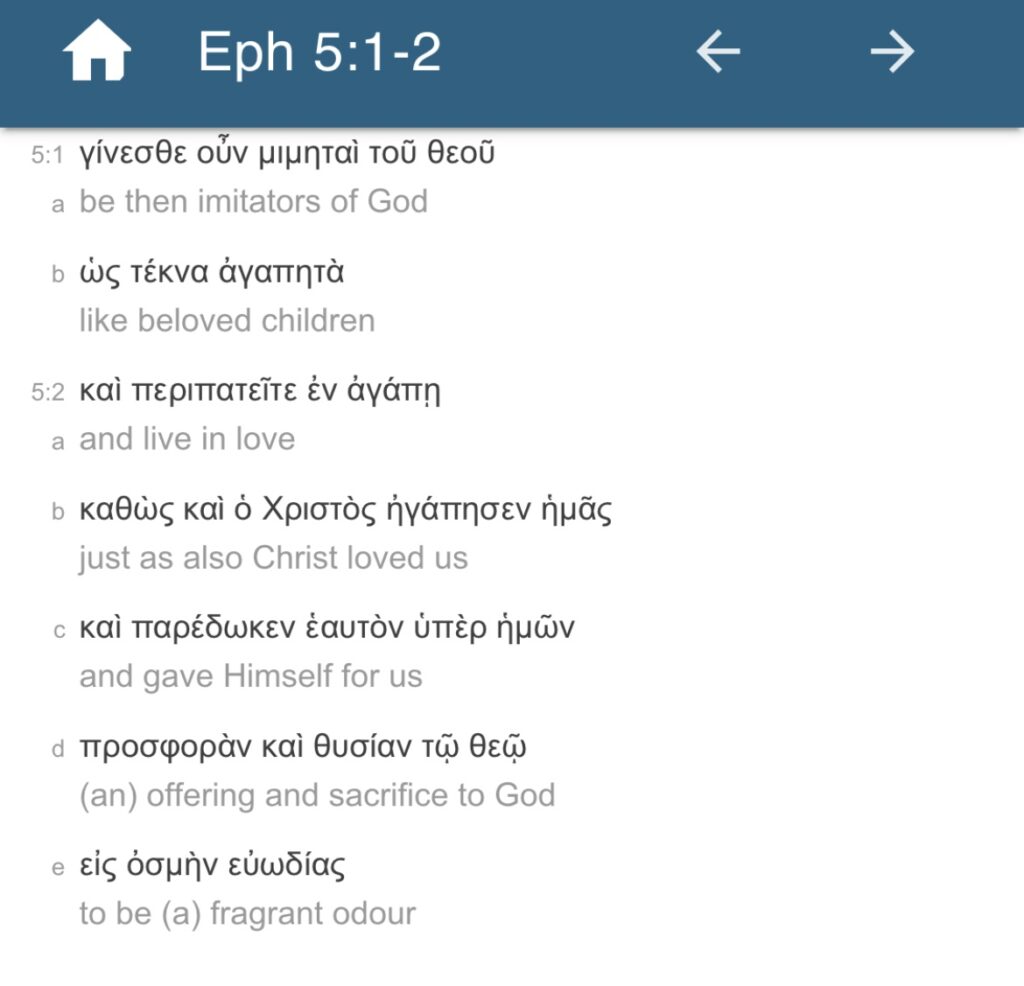
Because “kai” is always in a simple form (that is, it is never inflected by various endings and prefixes), and its Koine letters mirror their English equivalents (k-a-i), identifying all the kai’s in a phrase, or verse, using SD is straightforward. Shown above, there are four kai’s in Eph 5:1-2: in the phrases 5:2a, 5:2b, 5:2c, and finally in 5:2d. As discussed in a separate post drilling down on these two verses, such kai’s carry a deeper meaning (in my view) than suggested by the simple, straightforward, and not wrong, translation of “and”in uses 1, 3, and 4 above, and by its more refined interpretation by Dr. Louw (who did the English translation in SD) with “also” for kai in its the second occurrence.
So, if for no other use, SD can be used to find the Koine kai in any text of interest, requiring no other extraction of the SD lexical or morphological features.
Drilling down on LN’s lexicon on the first use of kai in Eph 5:2, we have the below:
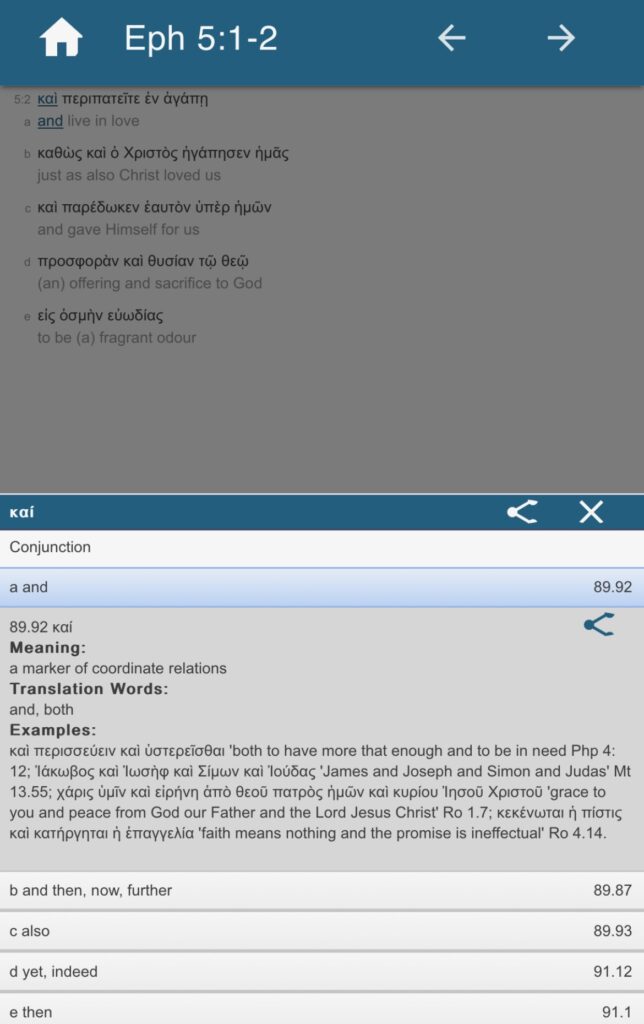
As discussed everywhere on this site, kai can have a much richer range of application and understanding than the brief summary given here in the LN lexicon for this particular use. As shown in the LN categories, it distinguishes give kinds of usages for kai, the simplest being the default “and.” All such distinctions are interpretations based upon the context as the morphology of kai gives no such conveyance. We will expand on such LN categories for kai in other discussions on this website.